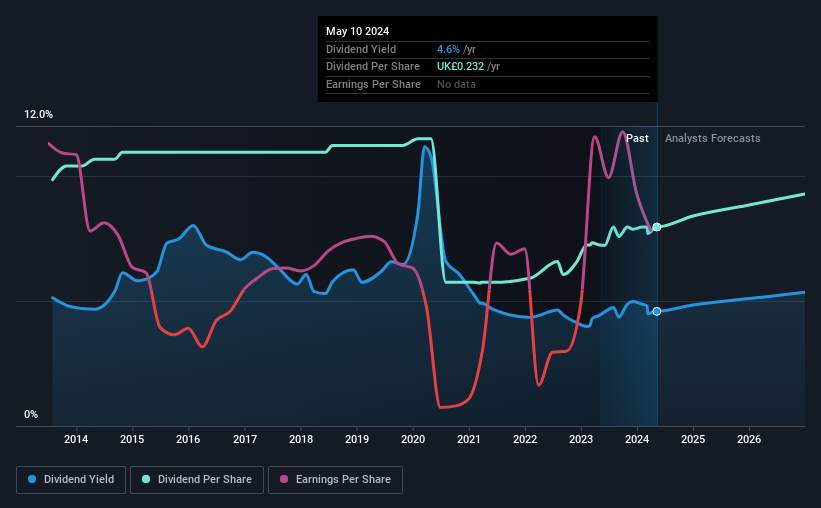Four Days Left To Buy BP p.l.c. (LON:BP.) Before The Ex-Dividend Date
BP p.l.c. (LON:BP.) stock is about to trade ex-dividend in 4 days. The ex-dividend date occurs one day before the record date which is the day on which shareholders need to be on the company's books in order to receive a dividend. The ex-dividend date is important because any transaction on a stock needs to have been settled before the record date in order to be eligible for a dividend. This means that investors who purchase BP's shares on or after the 16th of May will not receive the dividend, which will be paid on the 28th of June.
The company's next dividend payment will be US$0.0727 per share. Last year, in total, the company distributed US$0.28 to shareholders. Looking at the last 12 months of distributions, BP has a trailing yield of approximately 4.6% on its current stock price of UK£5.062. Dividends are a major contributor to investment returns for long term holders, but only if the dividend continues to be paid. As a result, readers should always check whether BP has been able to grow its dividends, or if the dividend might be cut.
Check out our latest analysis for BP
If a company pays out more in dividends than it earned, then the dividend might become unsustainable - hardly an ideal situation. BP paid out 53% of its earnings to investors last year, a normal payout level for most businesses. Yet cash flows are even more important than profits for assessing a dividend, so we need to see if the company generated enough cash to pay its distribution. Thankfully its dividend payments took up just 33% of the free cash flow it generated, which is a comfortable payout ratio.
It's encouraging to see that the dividend is covered by both profit and cash flow. This generally suggests the dividend is sustainable, as long as earnings don't drop precipitously.
Click here to see the company's payout ratio, plus analyst estimates of its future dividends.
Have Earnings And Dividends Been Growing?
Stocks in companies that generate sustainable earnings growth often make the best dividend prospects, as it is easier to lift the dividend when earnings are rising. If earnings decline and the company is forced to cut its dividend, investors could watch the value of their investment go up in smoke. With that in mind, we're encouraged by the steady growth at BP, with earnings per share up 3.8% on average over the last five years. Earnings growth has been slim and the company is paying out more than half of its earnings. While there is some room to both increase the payout ratio and reinvest in the business, generally the higher a payout ratio goes, the lower a company's prospects for future growth.
Many investors will assess a company's dividend performance by evaluating how much the dividend payments have changed over time. BP's dividend payments per share have declined at 2.1% per year on average over the past 10 years, which is uninspiring. BP is a rare case where dividends have been decreasing at the same time as earnings per share have been improving. It's unusual to see, and could point to unstable conditions in the core business, or more rarely an intensified focus on reinvesting profits.
The Bottom Line
Is BP worth buying for its dividend? Earnings per share growth has been modest and BP paid out over half of its profits and less than half of its free cash flow, although both payout ratios are within normal limits. In summary, it's hard to get excited about BP from a dividend perspective.
While it's tempting to invest in BP for the dividends alone, you should always be mindful of the risks involved. For example, we've found 2 warning signs for BP that we recommend you consider before investing in the business.
A common investing mistake is buying the first interesting stock you see. Here you can find a full list of high-yield dividend stocks.
Have feedback on this article? Concerned about the content? Get in touch with us directly. Alternatively, email editorial-team (at) simplywallst.com.
This article by Simply Wall St is general in nature. We provide commentary based on historical data and analyst forecasts only using an unbiased methodology and our articles are not intended to be financial advice. It does not constitute a recommendation to buy or sell any stock, and does not take account of your objectives, or your financial situation. We aim to bring you long-term focused analysis driven by fundamental data. Note that our analysis may not factor in the latest price-sensitive company announcements or qualitative material. Simply Wall St has no position in any stocks mentioned.

 Yahoo Finance
Yahoo Finance 
